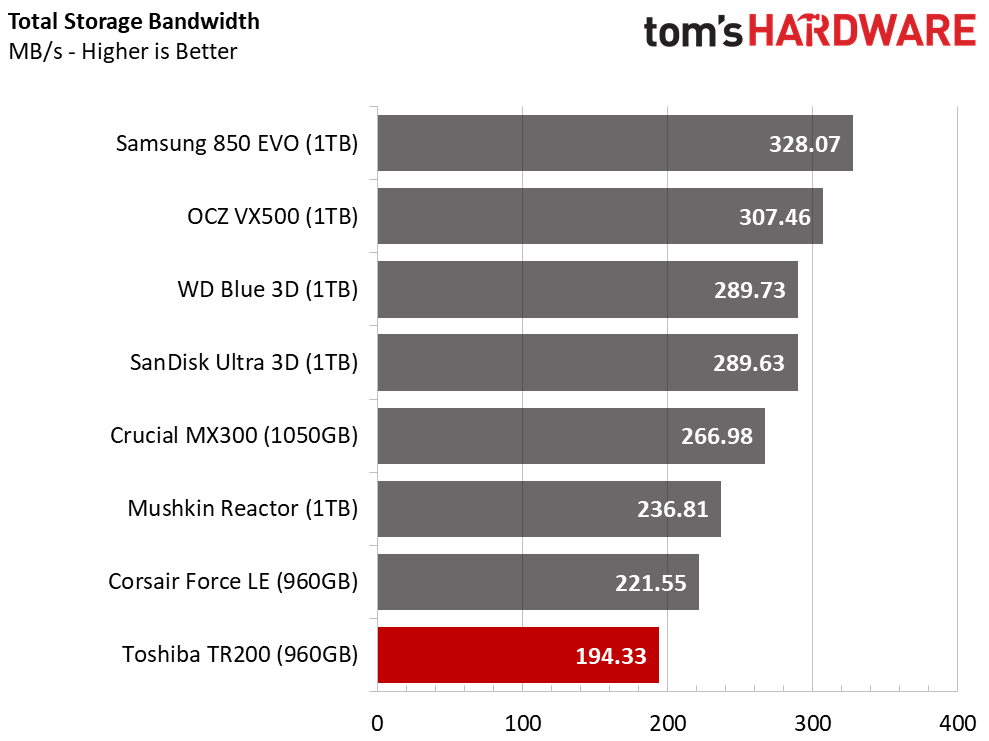Toshiba TR200 SSD Review
Why you can trust Tom's Hardware
1TB SSD Performance
Comparison Products
As we mentioned, the TR200 is one of the first 1TB retail DRAMless SSDs. Most SSDs store a logical-to-physical (L2P) address map in DRAM to speed data location, but larger SSDs require a larger map, and thus more DRAM. DRAMless SSDs remove the costly DRAM component and instead store the map on the flash. This technique increases latency during the mapping process, thus leading to reduced performance. The bestselling DRAMless controller of all time, the SandForce SF-2281, performed best with 256GB of flash, but the 512GB drives with the same controller were not as fast or as efficient, highlighting the challenges of storing a large L2P map directly on the flash.
Samsung’s EVO was first to bring 3D NAND to the consumer market, setting the bar for all SATA SSDs in the process. Since then every company has raced to bring their own flavors of 3D NAND to market. Toshiba is the last of the fab-powered companies to bring 3D NAND to its consumer SSDs, but from what we've observed in testing, the additional time to market paid off. Toshiba's BiCS is the closest to Samsung's performance thus far. Toshiba even managed to price the 1TB TR200 significantly under Samsung’s 850 EVO 1TB, but it's the only TR200 that is price-competitive with the EVO.
We have a couple of other new 3D-equipped models in our 1TB charts. The Crucial MX300 is an interesting product with its odd 1050GB capacity. The SanDisk Ultra 3D and WD Blue 3D are nearly identical in form and function, but there are some subtle price differences online.
We've also added some older planar SSDs to the charts. Those include the Corsair Force LE 960GB, Mushkin Reactor 1TB, and OCZ (Toshiba) VX500 1TB.
Sequential Read Performance
To read about our storage tests in-depth, please check out How We Test HDDs And SSDs. We cover four-corner testing on page six of our How We Test guide.


The TR200 1TB trails many of the other products in sequential read performance. We still managed to pull more than 500 MB/s at low queue depths, so you wouldn’t notice unless you were comparing the drives side-by-side.
Sequential Write Performance


The TR200's low sequential write performance is more concerning. This drive uses a controller that is similar to the Phison S11. Like Phison controllers, it runs a light compression algorithm on incoming data. Transfers move briskly if the data is compressible, but the write performance slows if the data is incompressible. That's compounded by the TLC sequential write performance drop off, which occurs after sustained write activity, and the lack of a DRAM buffer for the address map.
Get Tom's Hardware's best news and in-depth reviews, straight to your inbox.
Performance testing really depends on what type of data you use to exercise the drive. Some programs allow you to toggle between compressible and incompressible data, but you don't have those switches when you transfer real data to the drive. Many 4KB random files are highly compressible, but multimedia usually comes through in sequential transfers that are already compressed to some degree.
Random Read Performance

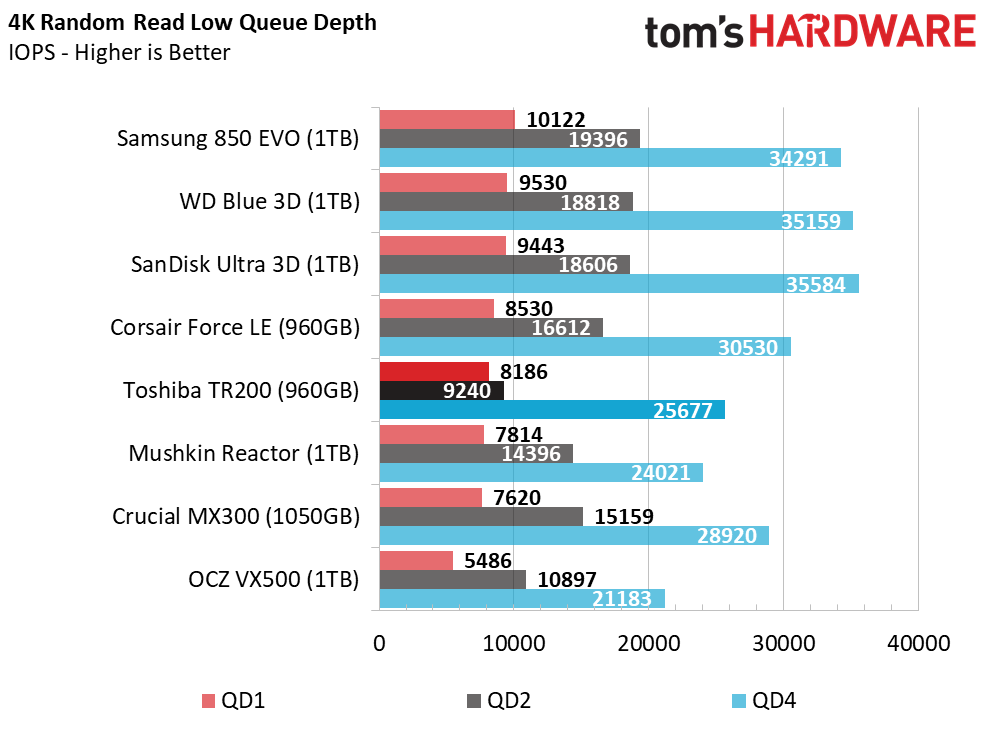

The TR200 960GB isn't the slowest product in our random read test, but it's certainly not in the same class as other 3D NAND SATA products with comparable capacities. We would have liked to see Toshiba either introduce a high-performance NVMe drive with the new BiCS NAND or bring something with a little more oomph for its sole SATA SSD in the 2017 line up.
Random Write Performance



The TR200 960GB falls to the bottom of our random write test at all queue depths. In theory, we should see the random write performance increase slightly as we measure smaller TR200 DRAMless drives. It's certainly something to keep an eye out for on the next couple of pages.
Random write performance has really shot up since the early days of consumer SSDs. The early SSDs, which were also DRAMless, had stutter problems and fewer random write IOPS than hard disk drives. The best consumer HDDs can now achieve around 300 random write IOPS at QD1. The TR200 delivers 50 times that amount. The TR200 960GB would certainly feel faster than a hard disk drive, but it has around 2x more random write latency than the 850 EVO 1TB.
80% Mixed Sequential Workload
We describe our mixed workload testing in detail here and describe our steady state tests here.
DRAMless architectures always suffer through our mixed workload tests. Here we ask the drive to read and write data at the same time. SATA is a half-duplex interface so technically it can't do both at the same time, but some controllers can switch between the tasks more rapidly. Native command queuing also helps, and some controllers handle that task better at the drive level than others.
80% Mixed Random Workload
The mixed random workload test reveals similar performance trends. The TR200 960GB trails the other drives through the entire queue depth range.
Sequential Steady-State



As you can take away from the other tests, the TR200 series is for the entry-level market and not designed for workstation workloads. We surely don't expect many people to run heavy sustained workloads on this drive. At least we hope not. If you do choose to let loose and pound the drive with professional applications, you can expect to see around half the performance of the other low-cost SSDs.
Random Steady-State


The Toshiba TR200 960 GB might be slow, but at least it's consistently slow. The TR200 is the only DRAMless 1TB model in the test group, so it’s at a disadvantage from the start. We would have compared the drive to other DRAMless 1TB models if they were available, but they simply don't exist (or the companies producing them have never supplied us with samples). We expect to see more of these products before the end of the year, and in 2018, most SATA SSDs will come in this configuration. Toshiba is just early to market with this design, so the TR200 will have to catch the first wave of criticism.
PCMark 8 Real-World Software Performance
For details on our real-world software performance testing, please click here.










Moving over to the real-world software tests, the TR200 960GB trails many of the other SATA SSDs.
Application Storage Bandwidth
This is quite literally the race to the bottom. That’s a saying we commonly use when we are talking about pricing, but with several quarters of the NAND shortage left, it takes on a new meaning.
PCMark 8 Advanced Workload Performance
To learn how we test advanced workload performance, please click here.

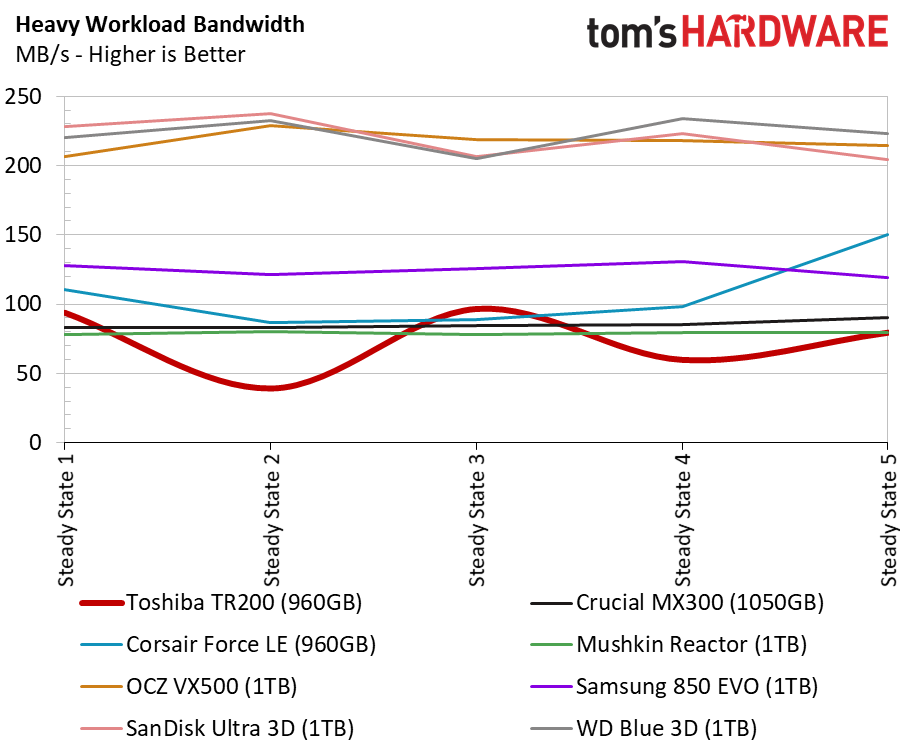

The performance charts speak for themselves. The drives are nearly full during this test. That means all the user-addressable space is dirty and the address map is fully populated. The SRAM inside the controller caches a small portion of the table map, but it is much smaller than a traditional DRAM buffer. Toshiba doesn't give us a lot of architectural information, so we don't know the SRAM capacity.
Total Service Time



The limited SRAM capacity becomes very clear in the service time test. The TR200 960GB recovers with some idle time, but it takes much longer than many of the other products.
Disk Busy Time
The TR200 960GB could recover with more idle time, but it would still have twice as much latency as the other 3D NAND SSDs in this group.
Responsiveness Test
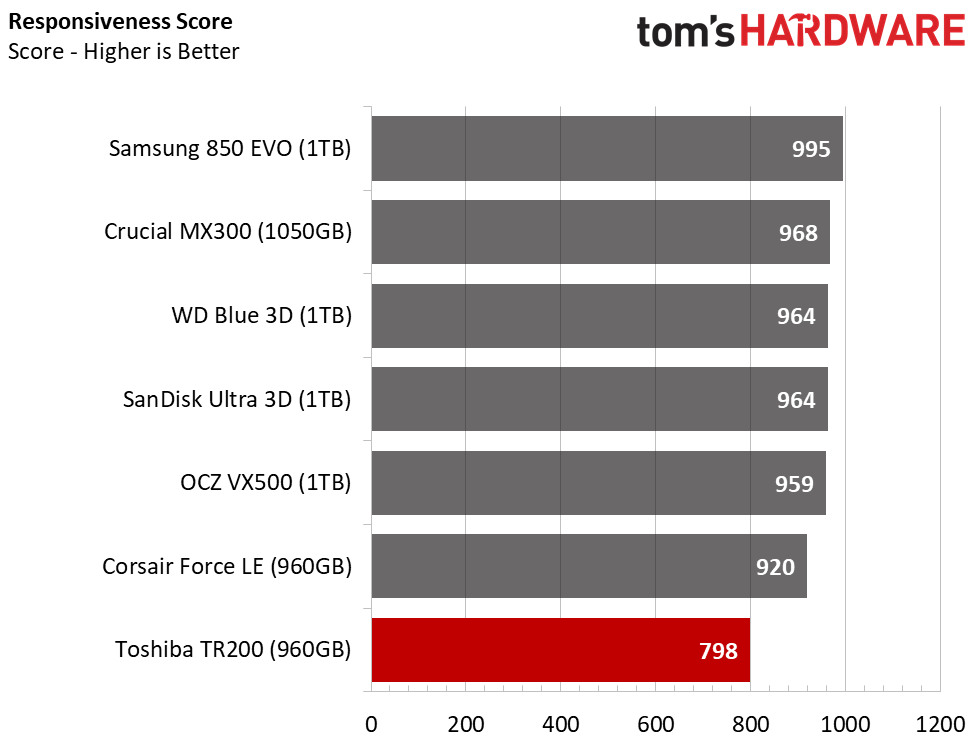
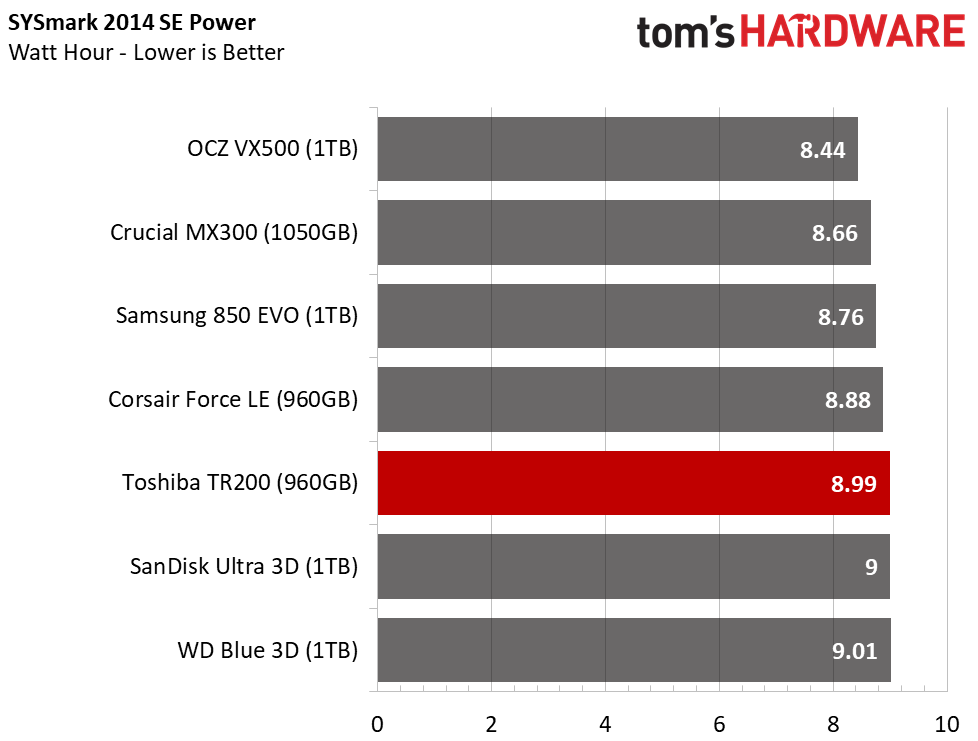
The large address map reduces performance. We see the story play out in BAPCo's SYSmark test, which measures system responsiveness in a Lenovo Y700-17 notebook. As you'll see on the following pages, the two smaller drives deliver a more responsive experience.
Notebook Battery Life


In theory, DRAMless SSDs use less power than other products with more power hungry components. Along with the reduced component costs, longer battery life is one of the big selling points for the technology. However, we discovered that the DRAMless SSDs have to work longer to complete the same tasks as DRAM-equipped SSDs. The quicker drives perform the tasks faster and then return to a lower power state before the DRAMless SSDs can. The additional time to completion negates the impact of removing the DRAM power consumption. We end up with SSDs that are not as fast, draw more power over time, and are not significantly cheaper.
MORE: Best SSDs
MORE: How We Test HDDs And SSDs
MORE: All SSD Content
Current page: 1TB SSD Performance
Prev Page Specifications & Pricing Next Page 512GB SSD Performance
Chris Ramseyer was a senior contributing editor for Tom's Hardware. He tested and reviewed consumer storage.
-
Sakkura Why do they even bother releasing this as a retail product. Just work with the manufacturers of laptops and prebuilt desktops, who are only looking for a cheap way to put "SSD" on their spec sheet and don't care about performance.Reply -
Flying-Q ReplyWe don't think the 240GB and 480GB are not worthy of consideration at launch pricing.
Can you sort out the double negative please? -
AgentLozen It drives me crazy thinking that companies like Toshiba are filled to the brim with talented engineers and yet they still think the best route forward is with a DRAMless design. Are you telling me that not a single high level person compared their SSDs to the competition and said "These things are garbage. Let's stop wasting our money developing them."Reply
Sakkura suggested that these SSDs are meant to be put into prebuilt desktops as a cheap means of adding an SSD to the spec sheet. In the conclusion, the author states that "The results do not justify the means, even with a $10 decrease in component expense. The only price that users care about is what they pay, and DRAMless SSDs are not cheaper than products already on the market." NOBODY benefits from DRAMless SSDs even in a $450 prebuilt desktop.
The situation is frustrating to me because I would rather have big companies like Toshiba not waste their effort designing this crap. I enjoy reading about disruptive new products that shake up the market. I want to experience the Back to the Future 2 utopian future. Products like this take us backwards to a dystopia where the world is ruled by tremendous idiots and as of 2017 we STILL don't have flying cars. -
2Be_or_Not2Be I really dislike DRAM-less controllers. Put this terribly-performing Trash-200 drive on the same level as the Intel 600p - that is, things not to buy!Reply -
gjbaker003 In the "Pricing & Warranty" section it suggests that the $89.99 SSD is 120GB, but the rest of the article states that the $89.99 SSD is 240GB. I would assume at that price point, that 240GB is the correct size of the drive?Reply -
mapesdhs (non-zero origin in the sequential read graph again)Reply
I bet if they were included, the 840 Pro, Vector, Vertex 4 and Neutron GTX from five years ago would still be better than these new Toshiba models. I long for the day when something as good as the 850 EVO is available at a price the 850 EVO was 2 years ago (250GB for 53 UKP, 500GB for 113 UKP).
Whatever happened to SanDisk's promise to release 8TB SSDs for the consumer market by now? -
derekullo Some one lied to Toshiba marketing.Reply
The drive barely hits 300 megabytes a second with that wavy pattern.
It almost looks like the drive was thermal throttling with that pattern. -
HERETIC-1 So sad-with Toshiba 3D available was thinking the "Race to the bottom"Reply
was finally over.
A few dollars worth of Ram could have possibly made these a decent SSD.
Thro the controller could also be part of the poor performance........... -
kookykrazee I will consider SATA technology outdated when I can get 6-10TB drives that are reasonably priced. That will not happen for awhile, so when I got a free $200 BB gift card I got a 8TB drive for $179. This replaced 3 1.5-3TB drives. Gained a few degrees in my case, too :)Reply





